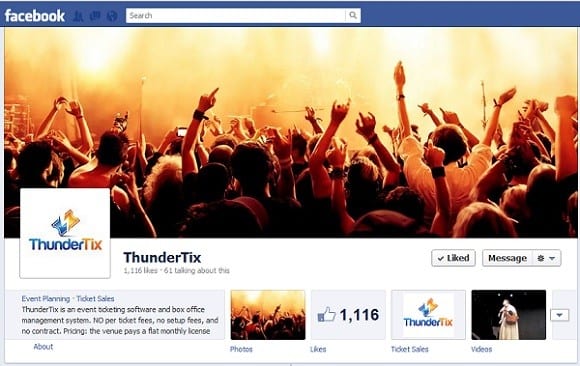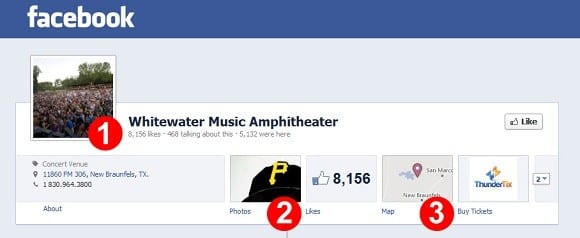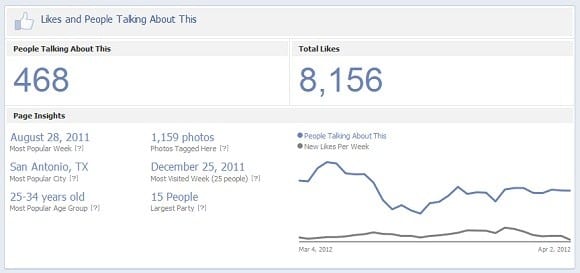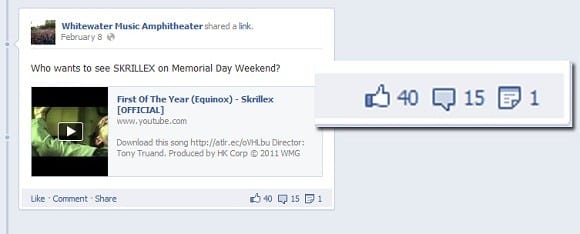
The benefits of a Facebook Page for your event or venue are numerous, now there are even more with the new Facebook Page Timeline format.
In a previous post, we explained the value of your venue or event having its own Facebook page.
“Venues without Facebook Pages lose out...There are no greater businesses to reap the rewards of all that Facebook offers than entertainment venues. Increased visibility to loyal fans and their friends, photos and multi-media offerings, coupons, and check-in deals offer huge advantages to your events and venue. You’ll also garner greater fan loyalty, and as the single greatest reward, you’ll sell more tickets.”
Since then, Facebook has been progressively upgrading both personal and business accounts to its new Timeline format. Timeline brings major changes to your Page and we strongly encourage you to review its impact.
Upgrade to the new Timeline format
As reported by ZDNet, Facebook has enabled the upgrade to the new Timeline design for all business Pages.
"All Facebook Pages are getting a mandatory Timeline update. Late last month, Facebook announced Timeline for Pages and started offering the update to Page administrators. While Timeline is mandatory, Page administrators have had about a month to curate their Page and were able to push out Timeline at any time they wanted. Today, that time is up."
Some feature highlights of Timeline for Pages include:
- Businesses and organizations can now add a cover photo to the top of their Page.
- When someone first visits a Page, they may see friends’ recent posts spotlighted as friend activity. People will also see how many of their friends are connected to a Page.
- The new Page design allows Page owners to tell stories through bigger photos and milestones that can include a date and other content.
Facebook has written an excellent guide [pdf] and we strongly recommend that you take the time to read it as you make the transition to Timeline.
In addition to the generic Facebook Timeline guide, below we have outlined some of the basics specific to venues and events Pages.
Timeline basics for venues and events

1. Summary of likes, activity and "page views"First is the at-a-glance summary that lets you quickly see usage of your Page by your ticket buyers. This single line summary shows total “likes”, “talking about” ( written comments ) and “were here” ( page views ). Great for when you are in a hurry, but the summary alone won’t let you gain insight into the excitement building around your upcoming event.
2. LikesThe ubiquitous Facebook “like” shown in total for all your posts. Clicking on the total “likes” opens a new page, as seen below:

More detailed information is listed under “Page Insights”. It is important to note that this information can be seen by everyone, not just you or your Page administrator.
3. Buy ticketsTimeline makes the link to buy tickets much more prominent than before ( You’ve enabled ticket buying on your Page right? ) so the opportunity for you to convert every “like” and “were here” into a sale is better than ever. Key to that conversion is telling a compelling “story”, which is exactly what the new Timeline format is designed to do.
How to use your Page Timeline to tell a memorable story
The real value of the new Timeline format is in its "storytelling" allegory designed by new Facebook employee Nicholas Felton. Felton explains the nature of his work as:
“I'm using the tools of data visualization to do storytelling. I'm interested in just finding ways of creating a record of existence and behavior, and seeing what it looks like, and trying to figure out what the aggregates have to share.”
As you add a new event to your Facebook Page, you begin a new story with a new post. The frequency and amount of posts you make for a specific event is up to you, but in general it should be similar to the structure of film: a prologe, three Acts and an epiloge.
Before your event tickets go on sale, make a “teaser” post ( prologue ). You can be as coy as you would like, posting a link to a video of the artist scheduled to perform for example:

As seen in the image above, there are forty “likes”, fifteen comments and one share for this single “teaser” post alone - and tickets haven’t even gone on sale yet!
Later, once you’ve made tickets available for purchase ( Act 1 ), you can upload a picture of the venue marquee, furthering the story along.
As anticipation builds ( Act 2 ), ticket buyers share your event posts with others explicitly, or implicitly via Page Timeline “frictionless sharing” -- posting a status for example, with no action needed on your part. Every interaction ( click the “like’ button ) ticket buyers make with your event’s story appears as an activity on their Facebook page and is seen by their friends.
Close to, or on the day of the event ( Act 3 ), as anticipation peaks, your story can become the center point of focus for all the attendees. “Parking is here!” with a link to a map, or “We’ll be at O'Doul's Bar” a couple hours before the show, stop by and say Hi!” are examples of what you can post.
 Finally, an often overlooked part of your event’s story is the follow-up call to action after the event is over ( epiloge ). Facebook has popular mobile app and it is very likely that your event attendees used it to capture the moment ( and the memory ) for themselves with photos and video. By scrolling backwards through your Page Timeline, the story shows comments “likes” as well as who made them. Click through to the event commenters and “likers” to see if they have shared photos and video of your event.
Finally, an often overlooked part of your event’s story is the follow-up call to action after the event is over ( epiloge ). Facebook has popular mobile app and it is very likely that your event attendees used it to capture the moment ( and the memory ) for themselves with photos and video. By scrolling backwards through your Page Timeline, the story shows comments “likes” as well as who made them. Click through to the event commenters and “likers” to see if they have shared photos and video of your event.
Always honor your ticket buyers privacy settings with a polite request for their permission to share their photos and videos on your Page. This can be a valuable “crowd sourced” resource for annual or recurring events like tours. As children we always want to hear a good story told over and over, and that holds true later in life as well. Everyone enjoys reliving fond memories of a cherished event.
Page Timeline cover image
Now that you have a better understanding of the value telling a compelling story provides, step one is to publish your Page with the new Timeline format using a nice cover image.
If you are familiar with photo editing software, a Timeline cover image needs to be at least 720 pixels wide, like the one you see on our Facebook Page. Use a photo that you have taken at one of your recent events, one of your event attendees photos as mentioned earlier, or browse photo sharing sites like Flickr and look for images licensed with the Creative Commons Share-a-Like license.
If editing photos is not your forté, we would be glad to help you create a great cover image for your Page. Just leave a comment below and let us know!